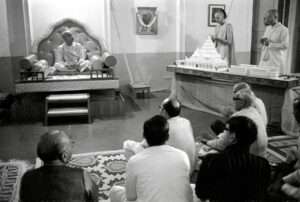
The glimmer of a Vaishnava, the materialistic Vaishnava, the marginal Vaishnava and the neophyte Vaishnava, all these words mean the same thing
Vaisnavabhasa, prakrta-vaishnava, vaisnava-praya o kanistha-vaisnava – ei sakala ekai katha
One who possesses an ordinary sraddha, who worships Deities but does not serve sadhus is a prakrta-Vaishnava[1], or a Vaishnava-praya[2].
This is a Vaishnavabhasa[3], and not a true Vaishnava. To become a Vaishnava, he must arrange for the association of sadhus.
Therefore, I consider Him to be a kanistha-Vaishnava[4]. By the mercy of devotees, he can become a Vaishnava.
The Intermediate Vaishnava
Madhyama Vaisnava
One in whom Krishna-prema is growing, who displays friendly behavior towards Krishna’s devotees, who is compassionate towards the innocent and shuns those who are envious, such a person is a madhyama-bhakta. Very soon he will become a pure devotee and will become qualified to chant Krishna-nama.
The highest Vaishnava
Uttama Vaisnava
One who sees Krishna everywhere, who understands that everything rests in Krishna, and who considers Krishna as the wealth of his life, who sees no difference between a Vaishnava and a non-Vaishnava, such a person is an Uttama-Vaishnava[5]. Krishna-nama is essentially everything to him.
An intermediate Vaishnava has to serve the Sadhus
Madhyama Vaisnava-i sadhu seva karena
Therefore, a respectable Madhyama-Vaishnava must certainly serve this type of sadhu constantly.
The materialistic devotee is qualified for Namabhasa
Prakrta-Vaisnava namabhasera adhikari
All the Sastras state that Prakrta-Vaishnavas, or Vaishnava-prayas, are eligible to chant namabhasa.
The intermediate Vaishnava is qualified for the Holy Name, but must be cautious regarding offenses to the Name
Madhyama-Vaisnava namadhikari o namaparadha vicara karibena
The Madhyama-Vaishnava is eligible to chant the Name, but he must be careful of offenses while practicing sri nama-bhajana.
It is impossible for an Uttama-Vaishnava to commit offence, because he sees the opulence of Krishna everywhere.
Considering one’s qualification, one should refrain from the offense of criticizing sadhus.
Keeping in the company of sadhus, offering service to them, practicing nama-sankirtana, and showing mercy to all Jivas, this is the conduct of a devotee.
[1] A materialistic Vaishnava.
[2] A marginal Vaishnava.
[3] A glimmer of a Vaishnava.
[4] A neophyte Vaishnava.
[5] The highest Vaishnava.
This is a section of the book “Harinama Cintamani (English)”.
To buy the complete book, click above
Post view 164 times



Leave a Reply